Building Design and Building Science: A Study of The Narrowest Home in London
VerifiedAdded on 2023/06/05
|12
|3794
|210
AI Summary
This report provides a descriptive study of The Narrowest Home in London, including its construction, structural and non-structural elements, and the behavior of materials used. It also discusses the importance of building design and building science in the construction industry.
Contribute Materials
Your contribution can guide someone’s learning journey. Share your
documents today.
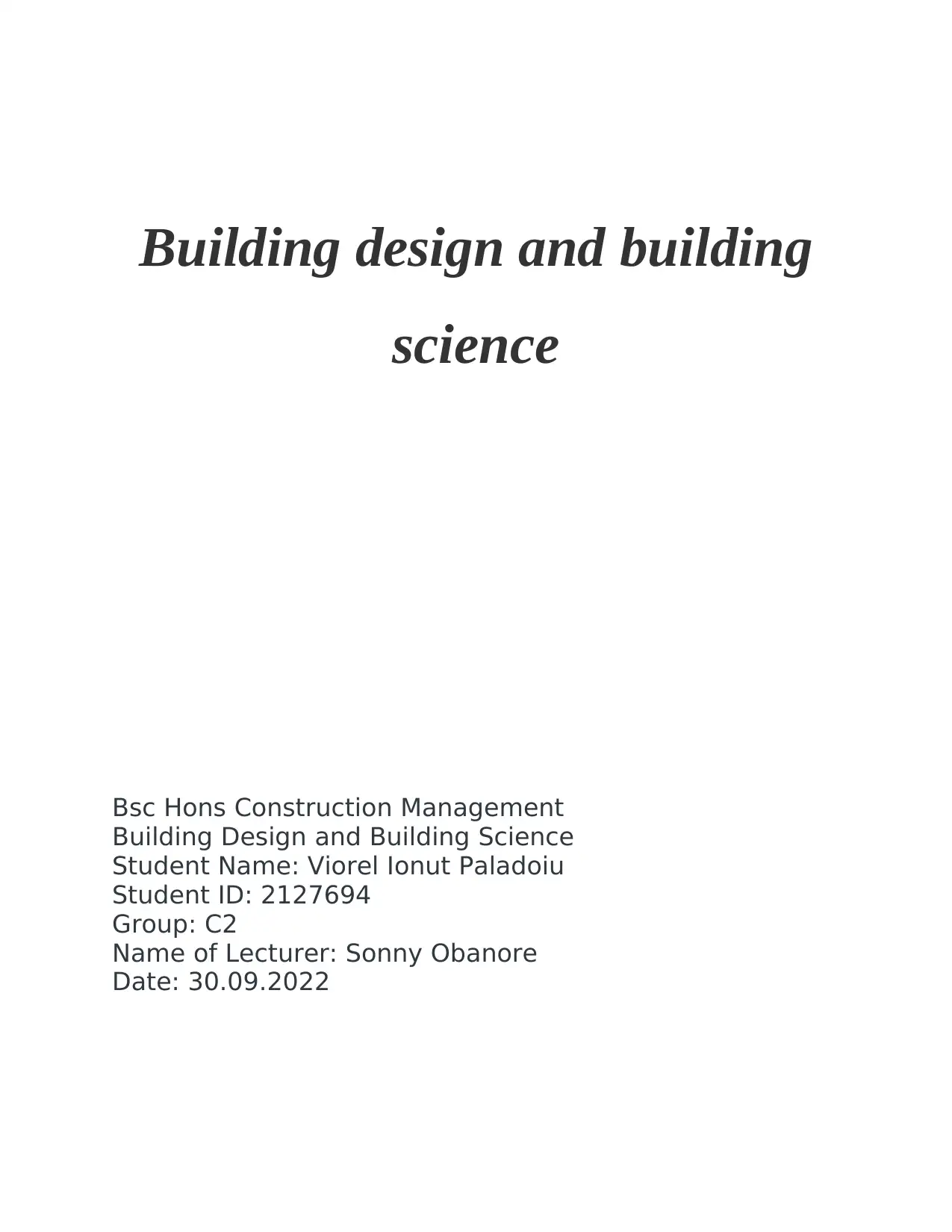
Building design and building
science
Bsc Hons Construction Management
Building Design and Building Science
Student Name: Viorel Ionut Paladoiu
Student ID: 2127694
Group: C2
Name of Lecturer: Sonny Obanore
Date: 30.09.2022
science
Bsc Hons Construction Management
Building Design and Building Science
Student Name: Viorel Ionut Paladoiu
Student ID: 2127694
Group: C2
Name of Lecturer: Sonny Obanore
Date: 30.09.2022
Secure Best Marks with AI Grader
Need help grading? Try our AI Grader for instant feedback on your assignments.
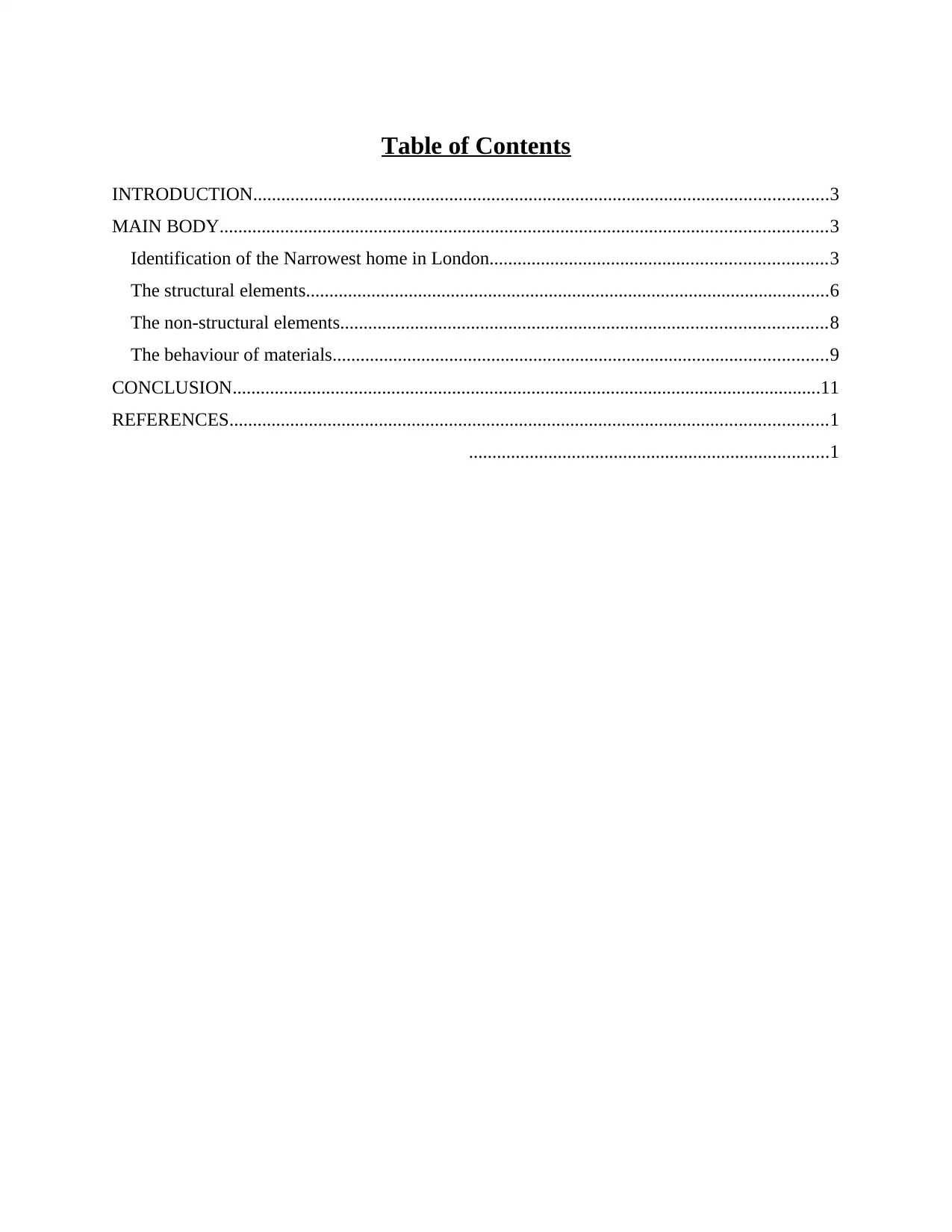
Table of Contents
INTRODUCTION...........................................................................................................................3
MAIN BODY..................................................................................................................................3
Identification of the Narrowest home in London........................................................................3
The structural elements................................................................................................................6
The non-structural elements........................................................................................................8
The behaviour of materials..........................................................................................................9
CONCLUSION..............................................................................................................................11
REFERENCES................................................................................................................................1
CONSERVING TRADITIONAL BUILDINGS.............................................................................1
INTRODUCTION...........................................................................................................................3
MAIN BODY..................................................................................................................................3
Identification of the Narrowest home in London........................................................................3
The structural elements................................................................................................................6
The non-structural elements........................................................................................................8
The behaviour of materials..........................................................................................................9
CONCLUSION..............................................................................................................................11
REFERENCES................................................................................................................................1
CONSERVING TRADITIONAL BUILDINGS.............................................................................1
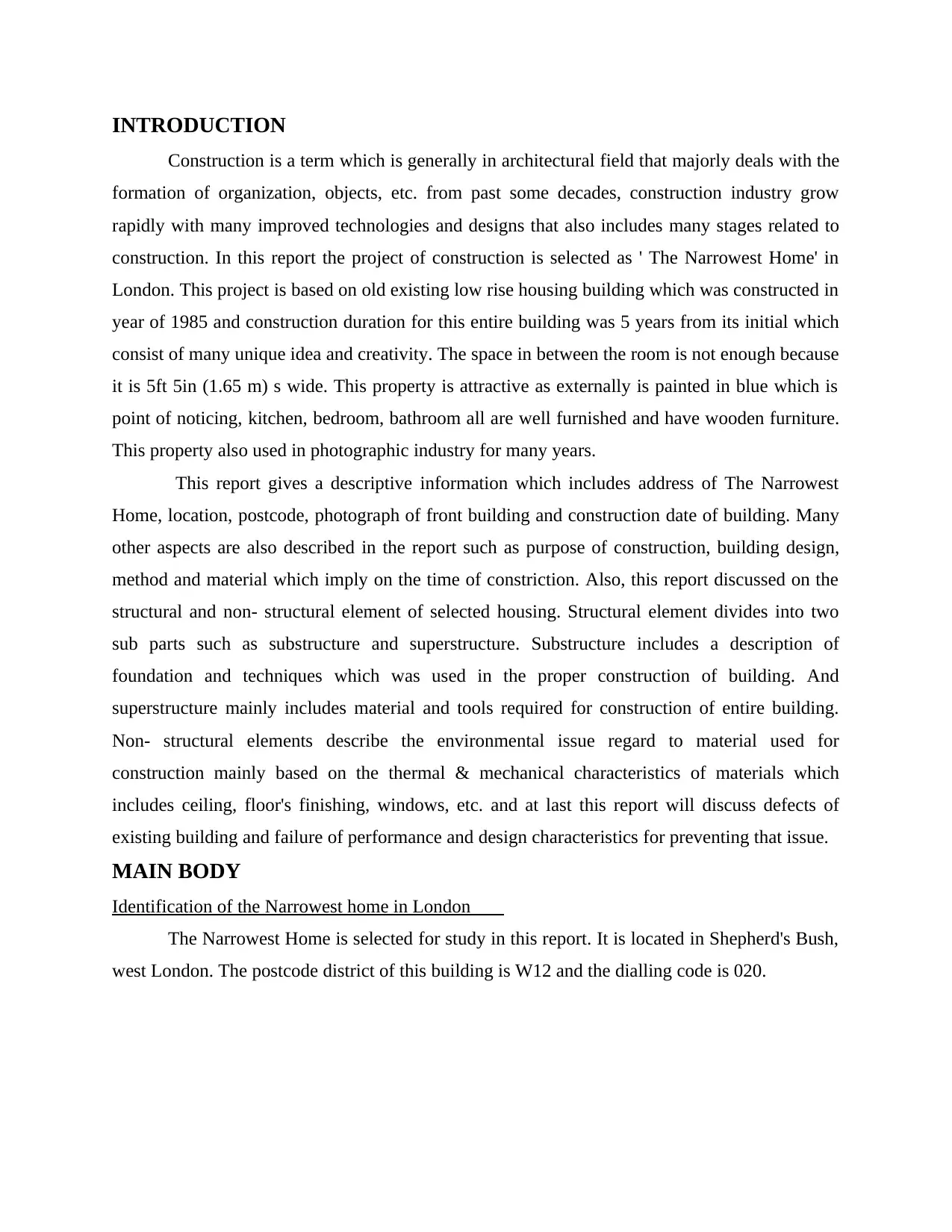
INTRODUCTION
Construction is a term which is generally in architectural field that majorly deals with the
formation of organization, objects, etc. from past some decades, construction industry grow
rapidly with many improved technologies and designs that also includes many stages related to
construction. In this report the project of construction is selected as ' The Narrowest Home' in
London. This project is based on old existing low rise housing building which was constructed in
year of 1985 and construction duration for this entire building was 5 years from its initial which
consist of many unique idea and creativity. The space in between the room is not enough because
it is 5ft 5in (1.65 m) s wide. This property is attractive as externally is painted in blue which is
point of noticing, kitchen, bedroom, bathroom all are well furnished and have wooden furniture.
This property also used in photographic industry for many years.
This report gives a descriptive information which includes address of The Narrowest
Home, location, postcode, photograph of front building and construction date of building. Many
other aspects are also described in the report such as purpose of construction, building design,
method and material which imply on the time of constriction. Also, this report discussed on the
structural and non- structural element of selected housing. Structural element divides into two
sub parts such as substructure and superstructure. Substructure includes a description of
foundation and techniques which was used in the proper construction of building. And
superstructure mainly includes material and tools required for construction of entire building.
Non- structural elements describe the environmental issue regard to material used for
construction mainly based on the thermal & mechanical characteristics of materials which
includes ceiling, floor's finishing, windows, etc. and at last this report will discuss defects of
existing building and failure of performance and design characteristics for preventing that issue.
MAIN BODY
Identification of the Narrowest home in London
The Narrowest Home is selected for study in this report. It is located in Shepherd's Bush,
west London. The postcode district of this building is W12 and the dialling code is 020.
Construction is a term which is generally in architectural field that majorly deals with the
formation of organization, objects, etc. from past some decades, construction industry grow
rapidly with many improved technologies and designs that also includes many stages related to
construction. In this report the project of construction is selected as ' The Narrowest Home' in
London. This project is based on old existing low rise housing building which was constructed in
year of 1985 and construction duration for this entire building was 5 years from its initial which
consist of many unique idea and creativity. The space in between the room is not enough because
it is 5ft 5in (1.65 m) s wide. This property is attractive as externally is painted in blue which is
point of noticing, kitchen, bedroom, bathroom all are well furnished and have wooden furniture.
This property also used in photographic industry for many years.
This report gives a descriptive information which includes address of The Narrowest
Home, location, postcode, photograph of front building and construction date of building. Many
other aspects are also described in the report such as purpose of construction, building design,
method and material which imply on the time of constriction. Also, this report discussed on the
structural and non- structural element of selected housing. Structural element divides into two
sub parts such as substructure and superstructure. Substructure includes a description of
foundation and techniques which was used in the proper construction of building. And
superstructure mainly includes material and tools required for construction of entire building.
Non- structural elements describe the environmental issue regard to material used for
construction mainly based on the thermal & mechanical characteristics of materials which
includes ceiling, floor's finishing, windows, etc. and at last this report will discuss defects of
existing building and failure of performance and design characteristics for preventing that issue.
MAIN BODY
Identification of the Narrowest home in London
The Narrowest Home is selected for study in this report. It is located in Shepherd's Bush,
west London. The postcode district of this building is W12 and the dialling code is 020.

Front view of the Building
Secure Best Marks with AI Grader
Need help grading? Try our AI Grader for instant feedback on your assignments.
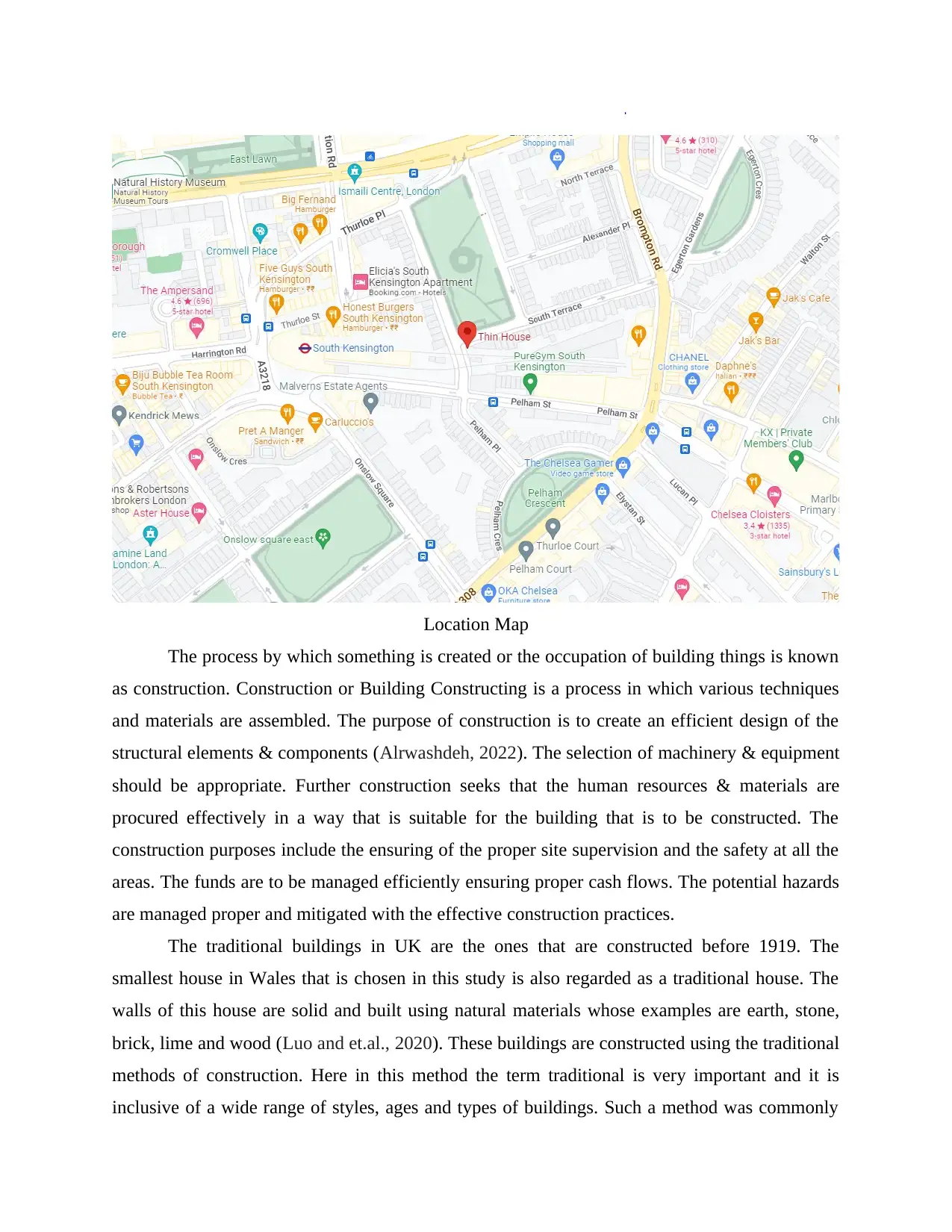
Location Map
The process by which something is created or the occupation of building things is known
as construction. Construction or Building Constructing is a process in which various techniques
and materials are assembled. The purpose of construction is to create an efficient design of the
structural elements & components (Alrwashdeh, 2022). The selection of machinery & equipment
should be appropriate. Further construction seeks that the human resources & materials are
procured effectively in a way that is suitable for the building that is to be constructed. The
construction purposes include the ensuring of the proper site supervision and the safety at all the
areas. The funds are to be managed efficiently ensuring proper cash flows. The potential hazards
are managed proper and mitigated with the effective construction practices.
The traditional buildings in UK are the ones that are constructed before 1919. The
smallest house in Wales that is chosen in this study is also regarded as a traditional house. The
walls of this house are solid and built using natural materials whose examples are earth, stone,
brick, lime and wood (Luo and et.al., 2020). These buildings are constructed using the traditional
methods of construction. Here in this method the term traditional is very important and it is
inclusive of a wide range of styles, ages and types of buildings. Such a method was commonly
The process by which something is created or the occupation of building things is known
as construction. Construction or Building Constructing is a process in which various techniques
and materials are assembled. The purpose of construction is to create an efficient design of the
structural elements & components (Alrwashdeh, 2022). The selection of machinery & equipment
should be appropriate. Further construction seeks that the human resources & materials are
procured effectively in a way that is suitable for the building that is to be constructed. The
construction purposes include the ensuring of the proper site supervision and the safety at all the
areas. The funds are to be managed efficiently ensuring proper cash flows. The potential hazards
are managed proper and mitigated with the effective construction practices.
The traditional buildings in UK are the ones that are constructed before 1919. The
smallest house in Wales that is chosen in this study is also regarded as a traditional house. The
walls of this house are solid and built using natural materials whose examples are earth, stone,
brick, lime and wood (Luo and et.al., 2020). These buildings are constructed using the traditional
methods of construction. Here in this method the term traditional is very important and it is
inclusive of a wide range of styles, ages and types of buildings. Such a method was commonly
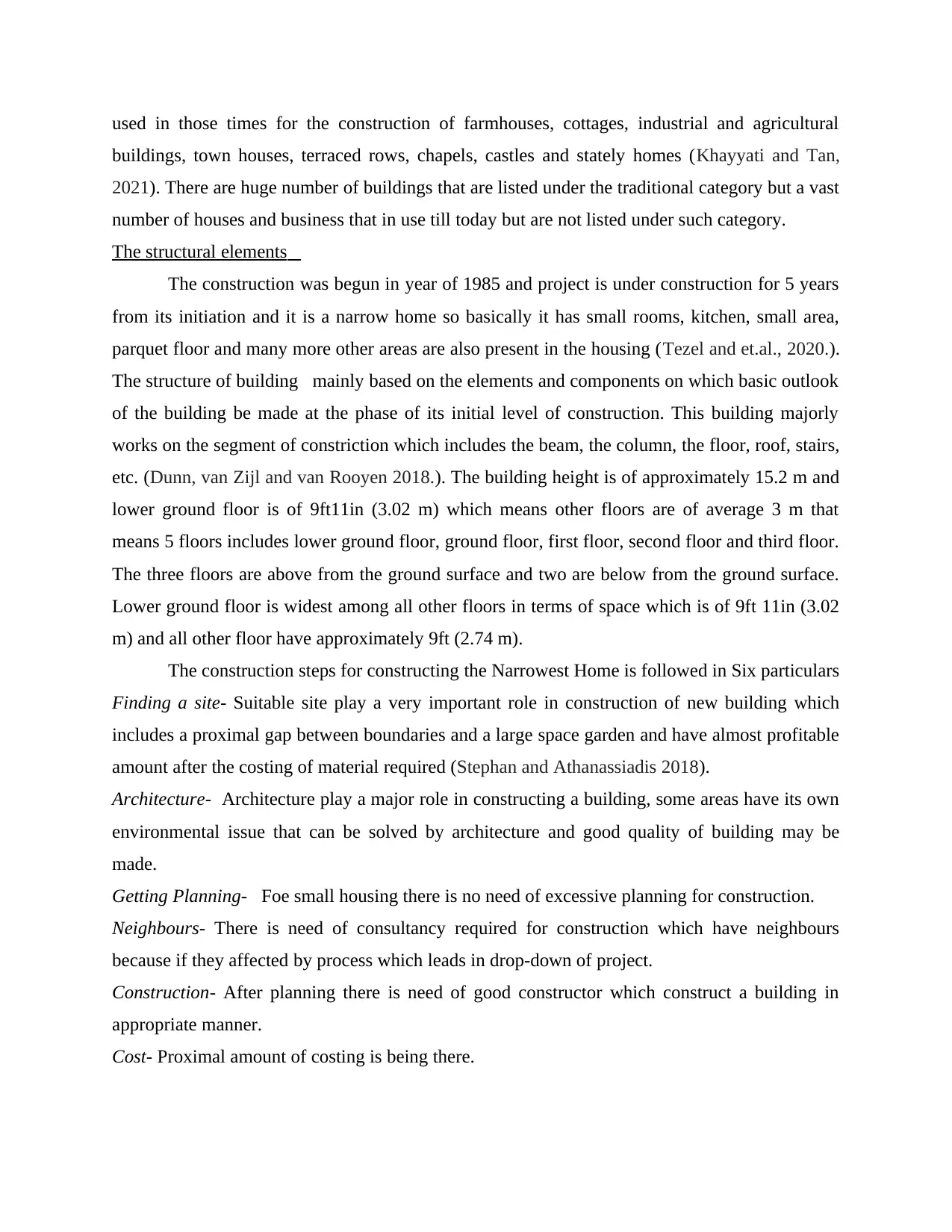
used in those times for the construction of farmhouses, cottages, industrial and agricultural
buildings, town houses, terraced rows, chapels, castles and stately homes (Khayyati and Tan,
2021). There are huge number of buildings that are listed under the traditional category but a vast
number of houses and business that in use till today but are not listed under such category.
The structural elements
The construction was begun in year of 1985 and project is under construction for 5 years
from its initiation and it is a narrow home so basically it has small rooms, kitchen, small area,
parquet floor and many more other areas are also present in the housing (Tezel and et.al., 2020.).
The structure of building mainly based on the elements and components on which basic outlook
of the building be made at the phase of its initial level of construction. This building majorly
works on the segment of constriction which includes the beam, the column, the floor, roof, stairs,
etc. (Dunn, van Zijl and van Rooyen 2018.). The building height is of approximately 15.2 m and
lower ground floor is of 9ft11in (3.02 m) which means other floors are of average 3 m that
means 5 floors includes lower ground floor, ground floor, first floor, second floor and third floor.
The three floors are above from the ground surface and two are below from the ground surface.
Lower ground floor is widest among all other floors in terms of space which is of 9ft 11in (3.02
m) and all other floor have approximately 9ft (2.74 m).
The construction steps for constructing the Narrowest Home is followed in Six particulars
Finding a site- Suitable site play a very important role in construction of new building which
includes a proximal gap between boundaries and a large space garden and have almost profitable
amount after the costing of material required (Stephan and Athanassiadis 2018).
Architecture- Architecture play a major role in constructing a building, some areas have its own
environmental issue that can be solved by architecture and good quality of building may be
made.
Getting Planning- Foe small housing there is no need of excessive planning for construction.
Neighbours- There is need of consultancy required for construction which have neighbours
because if they affected by process which leads in drop-down of project.
Construction- After planning there is need of good constructor which construct a building in
appropriate manner.
Cost- Proximal amount of costing is being there.
buildings, town houses, terraced rows, chapels, castles and stately homes (Khayyati and Tan,
2021). There are huge number of buildings that are listed under the traditional category but a vast
number of houses and business that in use till today but are not listed under such category.
The structural elements
The construction was begun in year of 1985 and project is under construction for 5 years
from its initiation and it is a narrow home so basically it has small rooms, kitchen, small area,
parquet floor and many more other areas are also present in the housing (Tezel and et.al., 2020.).
The structure of building mainly based on the elements and components on which basic outlook
of the building be made at the phase of its initial level of construction. This building majorly
works on the segment of constriction which includes the beam, the column, the floor, roof, stairs,
etc. (Dunn, van Zijl and van Rooyen 2018.). The building height is of approximately 15.2 m and
lower ground floor is of 9ft11in (3.02 m) which means other floors are of average 3 m that
means 5 floors includes lower ground floor, ground floor, first floor, second floor and third floor.
The three floors are above from the ground surface and two are below from the ground surface.
Lower ground floor is widest among all other floors in terms of space which is of 9ft 11in (3.02
m) and all other floor have approximately 9ft (2.74 m).
The construction steps for constructing the Narrowest Home is followed in Six particulars
Finding a site- Suitable site play a very important role in construction of new building which
includes a proximal gap between boundaries and a large space garden and have almost profitable
amount after the costing of material required (Stephan and Athanassiadis 2018).
Architecture- Architecture play a major role in constructing a building, some areas have its own
environmental issue that can be solved by architecture and good quality of building may be
made.
Getting Planning- Foe small housing there is no need of excessive planning for construction.
Neighbours- There is need of consultancy required for construction which have neighbours
because if they affected by process which leads in drop-down of project.
Construction- After planning there is need of good constructor which construct a building in
appropriate manner.
Cost- Proximal amount of costing is being there.
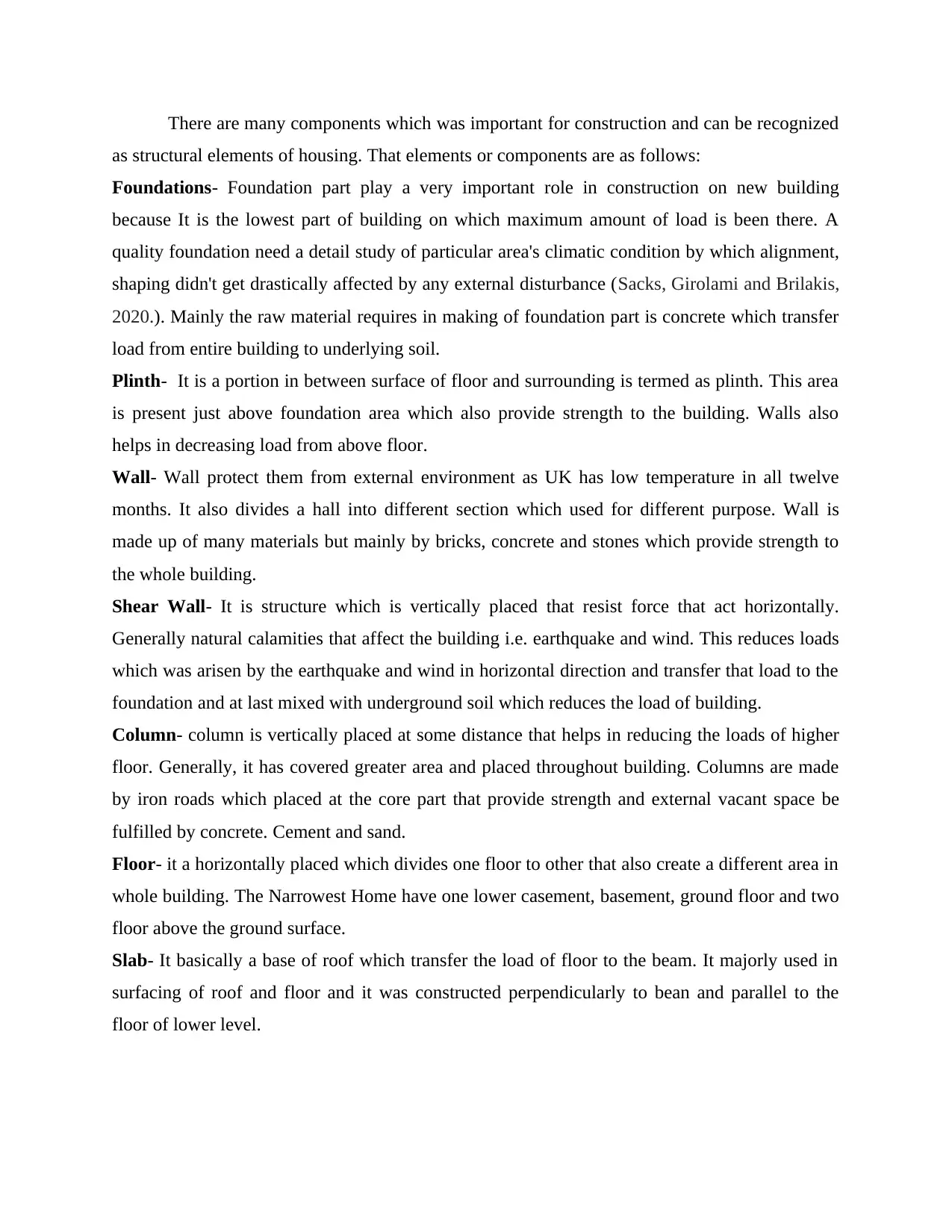
There are many components which was important for construction and can be recognized
as structural elements of housing. That elements or components are as follows:
Foundations- Foundation part play a very important role in construction on new building
because It is the lowest part of building on which maximum amount of load is been there. A
quality foundation need a detail study of particular area's climatic condition by which alignment,
shaping didn't get drastically affected by any external disturbance (Sacks, Girolami and Brilakis,
2020.). Mainly the raw material requires in making of foundation part is concrete which transfer
load from entire building to underlying soil.
Plinth- It is a portion in between surface of floor and surrounding is termed as plinth. This area
is present just above foundation area which also provide strength to the building. Walls also
helps in decreasing load from above floor.
Wall- Wall protect them from external environment as UK has low temperature in all twelve
months. It also divides a hall into different section which used for different purpose. Wall is
made up of many materials but mainly by bricks, concrete and stones which provide strength to
the whole building.
Shear Wall- It is structure which is vertically placed that resist force that act horizontally.
Generally natural calamities that affect the building i.e. earthquake and wind. This reduces loads
which was arisen by the earthquake and wind in horizontal direction and transfer that load to the
foundation and at last mixed with underground soil which reduces the load of building.
Column- column is vertically placed at some distance that helps in reducing the loads of higher
floor. Generally, it has covered greater area and placed throughout building. Columns are made
by iron roads which placed at the core part that provide strength and external vacant space be
fulfilled by concrete. Cement and sand.
Floor- it a horizontally placed which divides one floor to other that also create a different area in
whole building. The Narrowest Home have one lower casement, basement, ground floor and two
floor above the ground surface.
Slab- It basically a base of roof which transfer the load of floor to the beam. It majorly used in
surfacing of roof and floor and it was constructed perpendicularly to bean and parallel to the
floor of lower level.
as structural elements of housing. That elements or components are as follows:
Foundations- Foundation part play a very important role in construction on new building
because It is the lowest part of building on which maximum amount of load is been there. A
quality foundation need a detail study of particular area's climatic condition by which alignment,
shaping didn't get drastically affected by any external disturbance (Sacks, Girolami and Brilakis,
2020.). Mainly the raw material requires in making of foundation part is concrete which transfer
load from entire building to underlying soil.
Plinth- It is a portion in between surface of floor and surrounding is termed as plinth. This area
is present just above foundation area which also provide strength to the building. Walls also
helps in decreasing load from above floor.
Wall- Wall protect them from external environment as UK has low temperature in all twelve
months. It also divides a hall into different section which used for different purpose. Wall is
made up of many materials but mainly by bricks, concrete and stones which provide strength to
the whole building.
Shear Wall- It is structure which is vertically placed that resist force that act horizontally.
Generally natural calamities that affect the building i.e. earthquake and wind. This reduces loads
which was arisen by the earthquake and wind in horizontal direction and transfer that load to the
foundation and at last mixed with underground soil which reduces the load of building.
Column- column is vertically placed at some distance that helps in reducing the loads of higher
floor. Generally, it has covered greater area and placed throughout building. Columns are made
by iron roads which placed at the core part that provide strength and external vacant space be
fulfilled by concrete. Cement and sand.
Floor- it a horizontally placed which divides one floor to other that also create a different area in
whole building. The Narrowest Home have one lower casement, basement, ground floor and two
floor above the ground surface.
Slab- It basically a base of roof which transfer the load of floor to the beam. It majorly used in
surfacing of roof and floor and it was constructed perpendicularly to bean and parallel to the
floor of lower level.
Paraphrase This Document
Need a fresh take? Get an instant paraphrase of this document with our AI Paraphraser
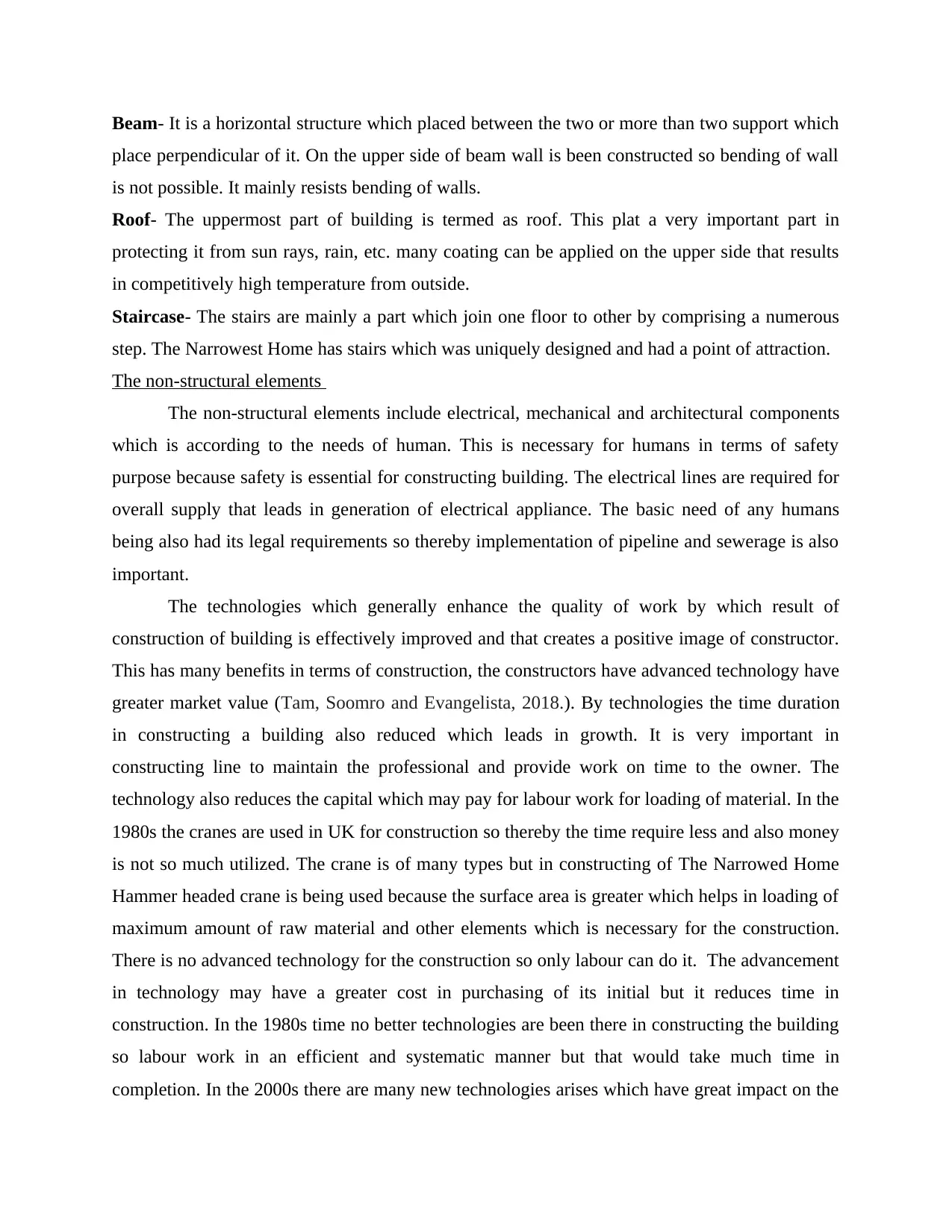
Beam- It is a horizontal structure which placed between the two or more than two support which
place perpendicular of it. On the upper side of beam wall is been constructed so bending of wall
is not possible. It mainly resists bending of walls.
Roof- The uppermost part of building is termed as roof. This plat a very important part in
protecting it from sun rays, rain, etc. many coating can be applied on the upper side that results
in competitively high temperature from outside.
Staircase- The stairs are mainly a part which join one floor to other by comprising a numerous
step. The Narrowest Home has stairs which was uniquely designed and had a point of attraction.
The non-structural elements
The non-structural elements include electrical, mechanical and architectural components
which is according to the needs of human. This is necessary for humans in terms of safety
purpose because safety is essential for constructing building. The electrical lines are required for
overall supply that leads in generation of electrical appliance. The basic need of any humans
being also had its legal requirements so thereby implementation of pipeline and sewerage is also
important.
The technologies which generally enhance the quality of work by which result of
construction of building is effectively improved and that creates a positive image of constructor.
This has many benefits in terms of construction, the constructors have advanced technology have
greater market value (Tam, Soomro and Evangelista, 2018.). By technologies the time duration
in constructing a building also reduced which leads in growth. It is very important in
constructing line to maintain the professional and provide work on time to the owner. The
technology also reduces the capital which may pay for labour work for loading of material. In the
1980s the cranes are used in UK for construction so thereby the time require less and also money
is not so much utilized. The crane is of many types but in constructing of The Narrowed Home
Hammer headed crane is being used because the surface area is greater which helps in loading of
maximum amount of raw material and other elements which is necessary for the construction.
There is no advanced technology for the construction so only labour can do it. The advancement
in technology may have a greater cost in purchasing of its initial but it reduces time in
construction. In the 1980s time no better technologies are been there in constructing the building
so labour work in an efficient and systematic manner but that would take much time in
completion. In the 2000s there are many new technologies arises which have great impact on the
place perpendicular of it. On the upper side of beam wall is been constructed so bending of wall
is not possible. It mainly resists bending of walls.
Roof- The uppermost part of building is termed as roof. This plat a very important part in
protecting it from sun rays, rain, etc. many coating can be applied on the upper side that results
in competitively high temperature from outside.
Staircase- The stairs are mainly a part which join one floor to other by comprising a numerous
step. The Narrowest Home has stairs which was uniquely designed and had a point of attraction.
The non-structural elements
The non-structural elements include electrical, mechanical and architectural components
which is according to the needs of human. This is necessary for humans in terms of safety
purpose because safety is essential for constructing building. The electrical lines are required for
overall supply that leads in generation of electrical appliance. The basic need of any humans
being also had its legal requirements so thereby implementation of pipeline and sewerage is also
important.
The technologies which generally enhance the quality of work by which result of
construction of building is effectively improved and that creates a positive image of constructor.
This has many benefits in terms of construction, the constructors have advanced technology have
greater market value (Tam, Soomro and Evangelista, 2018.). By technologies the time duration
in constructing a building also reduced which leads in growth. It is very important in
constructing line to maintain the professional and provide work on time to the owner. The
technology also reduces the capital which may pay for labour work for loading of material. In the
1980s the cranes are used in UK for construction so thereby the time require less and also money
is not so much utilized. The crane is of many types but in constructing of The Narrowed Home
Hammer headed crane is being used because the surface area is greater which helps in loading of
maximum amount of raw material and other elements which is necessary for the construction.
There is no advanced technology for the construction so only labour can do it. The advancement
in technology may have a greater cost in purchasing of its initial but it reduces time in
construction. In the 1980s time no better technologies are been there in constructing the building
so labour work in an efficient and systematic manner but that would take much time in
completion. In the 2000s there are many new technologies arises which have great impact on the
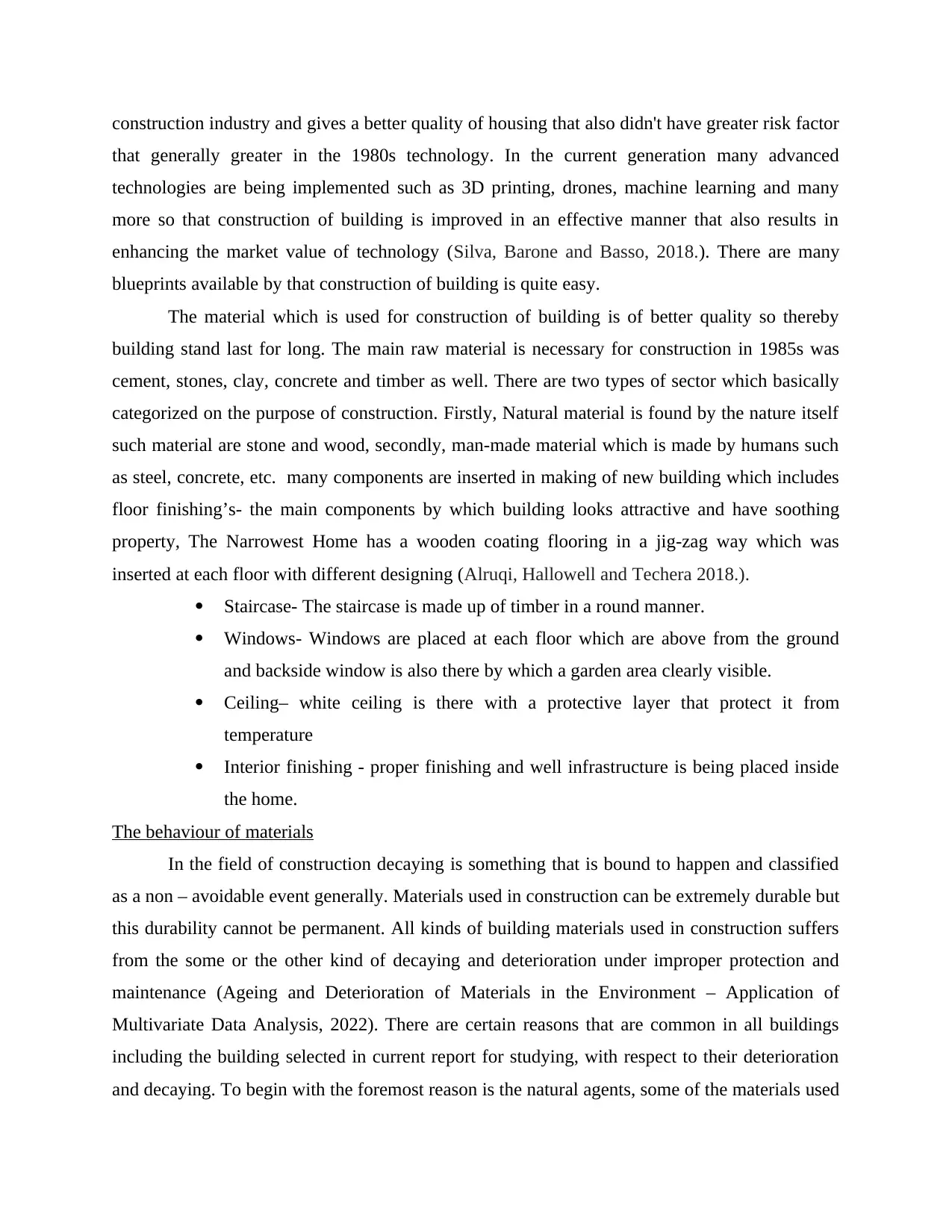
construction industry and gives a better quality of housing that also didn't have greater risk factor
that generally greater in the 1980s technology. In the current generation many advanced
technologies are being implemented such as 3D printing, drones, machine learning and many
more so that construction of building is improved in an effective manner that also results in
enhancing the market value of technology (Silva, Barone and Basso, 2018.). There are many
blueprints available by that construction of building is quite easy.
The material which is used for construction of building is of better quality so thereby
building stand last for long. The main raw material is necessary for construction in 1985s was
cement, stones, clay, concrete and timber as well. There are two types of sector which basically
categorized on the purpose of construction. Firstly, Natural material is found by the nature itself
such material are stone and wood, secondly, man-made material which is made by humans such
as steel, concrete, etc. many components are inserted in making of new building which includes
floor finishing’s- the main components by which building looks attractive and have soothing
property, The Narrowest Home has a wooden coating flooring in a jig-zag way which was
inserted at each floor with different designing (Alruqi, Hallowell and Techera 2018.).
Staircase- The staircase is made up of timber in a round manner.
Windows- Windows are placed at each floor which are above from the ground
and backside window is also there by which a garden area clearly visible.
Ceiling– white ceiling is there with a protective layer that protect it from
temperature
Interior finishing - proper finishing and well infrastructure is being placed inside
the home.
The behaviour of materials
In the field of construction decaying is something that is bound to happen and classified
as a non – avoidable event generally. Materials used in construction can be extremely durable but
this durability cannot be permanent. All kinds of building materials used in construction suffers
from the some or the other kind of decaying and deterioration under improper protection and
maintenance (Ageing and Deterioration of Materials in the Environment – Application of
Multivariate Data Analysis, 2022). There are certain reasons that are common in all buildings
including the building selected in current report for studying, with respect to their deterioration
and decaying. To begin with the foremost reason is the natural agents, some of the materials used
that generally greater in the 1980s technology. In the current generation many advanced
technologies are being implemented such as 3D printing, drones, machine learning and many
more so that construction of building is improved in an effective manner that also results in
enhancing the market value of technology (Silva, Barone and Basso, 2018.). There are many
blueprints available by that construction of building is quite easy.
The material which is used for construction of building is of better quality so thereby
building stand last for long. The main raw material is necessary for construction in 1985s was
cement, stones, clay, concrete and timber as well. There are two types of sector which basically
categorized on the purpose of construction. Firstly, Natural material is found by the nature itself
such material are stone and wood, secondly, man-made material which is made by humans such
as steel, concrete, etc. many components are inserted in making of new building which includes
floor finishing’s- the main components by which building looks attractive and have soothing
property, The Narrowest Home has a wooden coating flooring in a jig-zag way which was
inserted at each floor with different designing (Alruqi, Hallowell and Techera 2018.).
Staircase- The staircase is made up of timber in a round manner.
Windows- Windows are placed at each floor which are above from the ground
and backside window is also there by which a garden area clearly visible.
Ceiling– white ceiling is there with a protective layer that protect it from
temperature
Interior finishing - proper finishing and well infrastructure is being placed inside
the home.
The behaviour of materials
In the field of construction decaying is something that is bound to happen and classified
as a non – avoidable event generally. Materials used in construction can be extremely durable but
this durability cannot be permanent. All kinds of building materials used in construction suffers
from the some or the other kind of decaying and deterioration under improper protection and
maintenance (Ageing and Deterioration of Materials in the Environment – Application of
Multivariate Data Analysis, 2022). There are certain reasons that are common in all buildings
including the building selected in current report for studying, with respect to their deterioration
and decaying. To begin with the foremost reason is the natural agents, some of the materials used
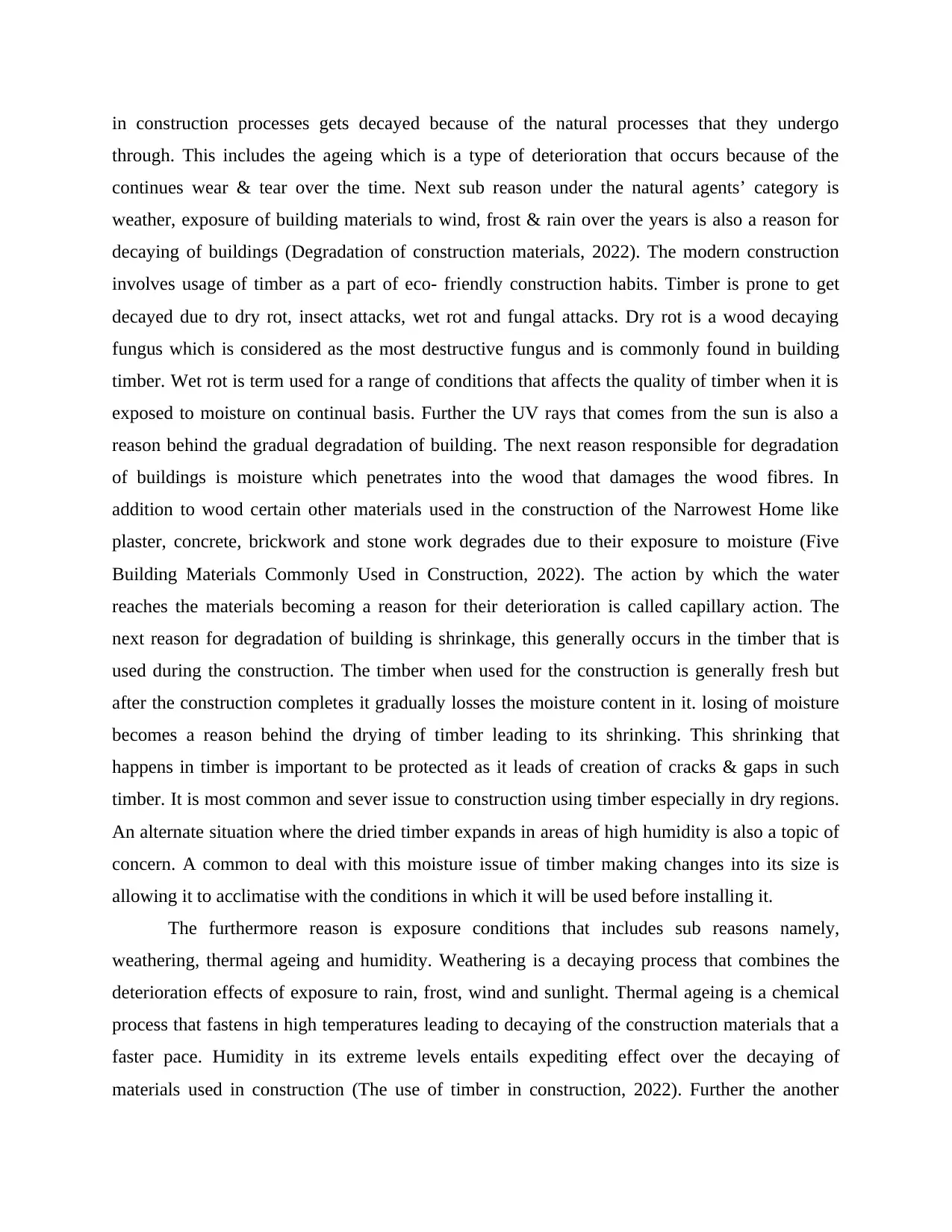
in construction processes gets decayed because of the natural processes that they undergo
through. This includes the ageing which is a type of deterioration that occurs because of the
continues wear & tear over the time. Next sub reason under the natural agents’ category is
weather, exposure of building materials to wind, frost & rain over the years is also a reason for
decaying of buildings (Degradation of construction materials, 2022). The modern construction
involves usage of timber as a part of eco- friendly construction habits. Timber is prone to get
decayed due to dry rot, insect attacks, wet rot and fungal attacks. Dry rot is a wood decaying
fungus which is considered as the most destructive fungus and is commonly found in building
timber. Wet rot is term used for a range of conditions that affects the quality of timber when it is
exposed to moisture on continual basis. Further the UV rays that comes from the sun is also a
reason behind the gradual degradation of building. The next reason responsible for degradation
of buildings is moisture which penetrates into the wood that damages the wood fibres. In
addition to wood certain other materials used in the construction of the Narrowest Home like
plaster, concrete, brickwork and stone work degrades due to their exposure to moisture (Five
Building Materials Commonly Used in Construction, 2022). The action by which the water
reaches the materials becoming a reason for their deterioration is called capillary action. The
next reason for degradation of building is shrinkage, this generally occurs in the timber that is
used during the construction. The timber when used for the construction is generally fresh but
after the construction completes it gradually losses the moisture content in it. losing of moisture
becomes a reason behind the drying of timber leading to its shrinking. This shrinking that
happens in timber is important to be protected as it leads of creation of cracks & gaps in such
timber. It is most common and sever issue to construction using timber especially in dry regions.
An alternate situation where the dried timber expands in areas of high humidity is also a topic of
concern. A common to deal with this moisture issue of timber making changes into its size is
allowing it to acclimatise with the conditions in which it will be used before installing it.
The furthermore reason is exposure conditions that includes sub reasons namely,
weathering, thermal ageing and humidity. Weathering is a decaying process that combines the
deterioration effects of exposure to rain, frost, wind and sunlight. Thermal ageing is a chemical
process that fastens in high temperatures leading to decaying of the construction materials that a
faster pace. Humidity in its extreme levels entails expediting effect over the decaying of
materials used in construction (The use of timber in construction, 2022). Further the another
through. This includes the ageing which is a type of deterioration that occurs because of the
continues wear & tear over the time. Next sub reason under the natural agents’ category is
weather, exposure of building materials to wind, frost & rain over the years is also a reason for
decaying of buildings (Degradation of construction materials, 2022). The modern construction
involves usage of timber as a part of eco- friendly construction habits. Timber is prone to get
decayed due to dry rot, insect attacks, wet rot and fungal attacks. Dry rot is a wood decaying
fungus which is considered as the most destructive fungus and is commonly found in building
timber. Wet rot is term used for a range of conditions that affects the quality of timber when it is
exposed to moisture on continual basis. Further the UV rays that comes from the sun is also a
reason behind the gradual degradation of building. The next reason responsible for degradation
of buildings is moisture which penetrates into the wood that damages the wood fibres. In
addition to wood certain other materials used in the construction of the Narrowest Home like
plaster, concrete, brickwork and stone work degrades due to their exposure to moisture (Five
Building Materials Commonly Used in Construction, 2022). The action by which the water
reaches the materials becoming a reason for their deterioration is called capillary action. The
next reason for degradation of building is shrinkage, this generally occurs in the timber that is
used during the construction. The timber when used for the construction is generally fresh but
after the construction completes it gradually losses the moisture content in it. losing of moisture
becomes a reason behind the drying of timber leading to its shrinking. This shrinking that
happens in timber is important to be protected as it leads of creation of cracks & gaps in such
timber. It is most common and sever issue to construction using timber especially in dry regions.
An alternate situation where the dried timber expands in areas of high humidity is also a topic of
concern. A common to deal with this moisture issue of timber making changes into its size is
allowing it to acclimatise with the conditions in which it will be used before installing it.
The furthermore reason is exposure conditions that includes sub reasons namely,
weathering, thermal ageing and humidity. Weathering is a decaying process that combines the
deterioration effects of exposure to rain, frost, wind and sunlight. Thermal ageing is a chemical
process that fastens in high temperatures leading to decaying of the construction materials that a
faster pace. Humidity in its extreme levels entails expediting effect over the decaying of
materials used in construction (The use of timber in construction, 2022). Further the another
Secure Best Marks with AI Grader
Need help grading? Try our AI Grader for instant feedback on your assignments.

reason is corrosion of metals, it is chemical process that initiates when the metal comes in
contact with something that is in liquid state. Oxidation is the name given to the most common
chemical process causing decaying of metals. Oxidation is the process that starts when a metal
reacts with the oxygen the most common example is rusting of iron. Loading is the next cause
behind the decaying of materials in construction. This consists of reasons like shock, static and
cyclic. The materials with low toughness are impacted by dynamic loads. Static is likely to cause
creep deformation in materials over time. The constant differing in dynamic loading makes a
reason behind fatigue in materials.
CONCLUSION
On the basis of the above report it has been cleared that construction is the term used for
referring to the action by which something that is of typically large structure is built. The report
has chosen The Narrowest home of Wales whose address and location map along with the
postcode and front photograph has been provided in the report. The report has described the
purpose, design, building methods and structural materials used in the construction of selected
building. Further the report has covered the structural elements of the building with the
substructure and superstructure. Also the non – structural elements and materials used in the
construction of the building such as floor’s finishings, staircase windows, etc. have been covered
in the study. Further the in this study it has been learnt that how the behaviour of the materials
that are used in construction decays and degrades.
contact with something that is in liquid state. Oxidation is the name given to the most common
chemical process causing decaying of metals. Oxidation is the process that starts when a metal
reacts with the oxygen the most common example is rusting of iron. Loading is the next cause
behind the decaying of materials in construction. This consists of reasons like shock, static and
cyclic. The materials with low toughness are impacted by dynamic loads. Static is likely to cause
creep deformation in materials over time. The constant differing in dynamic loading makes a
reason behind fatigue in materials.
CONCLUSION
On the basis of the above report it has been cleared that construction is the term used for
referring to the action by which something that is of typically large structure is built. The report
has chosen The Narrowest home of Wales whose address and location map along with the
postcode and front photograph has been provided in the report. The report has described the
purpose, design, building methods and structural materials used in the construction of selected
building. Further the report has covered the structural elements of the building with the
substructure and superstructure. Also the non – structural elements and materials used in the
construction of the building such as floor’s finishings, staircase windows, etc. have been covered
in the study. Further the in this study it has been learnt that how the behaviour of the materials
that are used in construction decays and degrades.
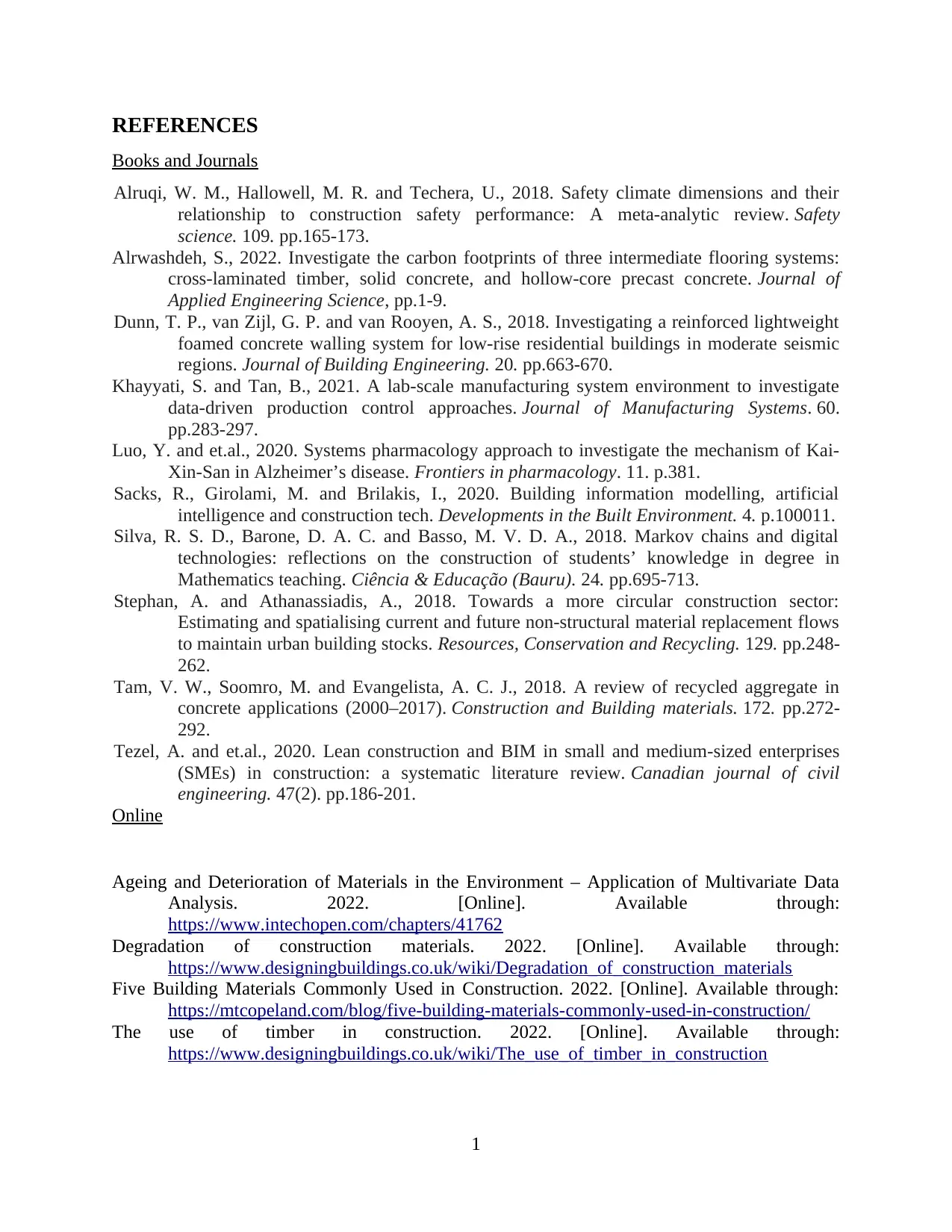
REFERENCES
Books and Journals
Alruqi, W. M., Hallowell, M. R. and Techera, U., 2018. Safety climate dimensions and their
relationship to construction safety performance: A meta-analytic review. Safety
science. 109. pp.165-173.
Alrwashdeh, S., 2022. Investigate the carbon footprints of three intermediate flooring systems:
cross-laminated timber, solid concrete, and hollow-core precast concrete. Journal of
Applied Engineering Science, pp.1-9.
Dunn, T. P., van Zijl, G. P. and van Rooyen, A. S., 2018. Investigating a reinforced lightweight
foamed concrete walling system for low-rise residential buildings in moderate seismic
regions. Journal of Building Engineering. 20. pp.663-670.
Khayyati, S. and Tan, B., 2021. A lab-scale manufacturing system environment to investigate
data-driven production control approaches. Journal of Manufacturing Systems. 60.
pp.283-297.
Luo, Y. and et.al., 2020. Systems pharmacology approach to investigate the mechanism of Kai-
Xin-San in Alzheimer’s disease. Frontiers in pharmacology. 11. p.381.
Sacks, R., Girolami, M. and Brilakis, I., 2020. Building information modelling, artificial
intelligence and construction tech. Developments in the Built Environment. 4. p.100011.
Silva, R. S. D., Barone, D. A. C. and Basso, M. V. D. A., 2018. Markov chains and digital
technologies: reflections on the construction of students’ knowledge in degree in
Mathematics teaching. Ciência & Educação (Bauru). 24. pp.695-713.
Stephan, A. and Athanassiadis, A., 2018. Towards a more circular construction sector:
Estimating and spatialising current and future non-structural material replacement flows
to maintain urban building stocks. Resources, Conservation and Recycling. 129. pp.248-
262.
Tam, V. W., Soomro, M. and Evangelista, A. C. J., 2018. A review of recycled aggregate in
concrete applications (2000–2017). Construction and Building materials. 172. pp.272-
292.
Tezel, A. and et.al., 2020. Lean construction and BIM in small and medium-sized enterprises
(SMEs) in construction: a systematic literature review. Canadian journal of civil
engineering. 47(2). pp.186-201.
Online
CONSERVING TRADITIONAL BUILDINGS
Ageing and Deterioration of Materials in the Environment – Application of Multivariate Data
Analysis. 2022. [Online]. Available through:
https://www.intechopen.com/chapters/41762
Degradation of construction materials. 2022. [Online]. Available through:
https://www.designingbuildings.co.uk/wiki/Degradation_of_construction_materials
Five Building Materials Commonly Used in Construction. 2022. [Online]. Available through:
https://mtcopeland.com/blog/five-building-materials-commonly-used-in-construction/
The use of timber in construction. 2022. [Online]. Available through:
https://www.designingbuildings.co.uk/wiki/The_use_of_timber_in_construction
1
Books and Journals
Alruqi, W. M., Hallowell, M. R. and Techera, U., 2018. Safety climate dimensions and their
relationship to construction safety performance: A meta-analytic review. Safety
science. 109. pp.165-173.
Alrwashdeh, S., 2022. Investigate the carbon footprints of three intermediate flooring systems:
cross-laminated timber, solid concrete, and hollow-core precast concrete. Journal of
Applied Engineering Science, pp.1-9.
Dunn, T. P., van Zijl, G. P. and van Rooyen, A. S., 2018. Investigating a reinforced lightweight
foamed concrete walling system for low-rise residential buildings in moderate seismic
regions. Journal of Building Engineering. 20. pp.663-670.
Khayyati, S. and Tan, B., 2021. A lab-scale manufacturing system environment to investigate
data-driven production control approaches. Journal of Manufacturing Systems. 60.
pp.283-297.
Luo, Y. and et.al., 2020. Systems pharmacology approach to investigate the mechanism of Kai-
Xin-San in Alzheimer’s disease. Frontiers in pharmacology. 11. p.381.
Sacks, R., Girolami, M. and Brilakis, I., 2020. Building information modelling, artificial
intelligence and construction tech. Developments in the Built Environment. 4. p.100011.
Silva, R. S. D., Barone, D. A. C. and Basso, M. V. D. A., 2018. Markov chains and digital
technologies: reflections on the construction of students’ knowledge in degree in
Mathematics teaching. Ciência & Educação (Bauru). 24. pp.695-713.
Stephan, A. and Athanassiadis, A., 2018. Towards a more circular construction sector:
Estimating and spatialising current and future non-structural material replacement flows
to maintain urban building stocks. Resources, Conservation and Recycling. 129. pp.248-
262.
Tam, V. W., Soomro, M. and Evangelista, A. C. J., 2018. A review of recycled aggregate in
concrete applications (2000–2017). Construction and Building materials. 172. pp.272-
292.
Tezel, A. and et.al., 2020. Lean construction and BIM in small and medium-sized enterprises
(SMEs) in construction: a systematic literature review. Canadian journal of civil
engineering. 47(2). pp.186-201.
Online
CONSERVING TRADITIONAL BUILDINGS
Ageing and Deterioration of Materials in the Environment – Application of Multivariate Data
Analysis. 2022. [Online]. Available through:
https://www.intechopen.com/chapters/41762
Degradation of construction materials. 2022. [Online]. Available through:
https://www.designingbuildings.co.uk/wiki/Degradation_of_construction_materials
Five Building Materials Commonly Used in Construction. 2022. [Online]. Available through:
https://mtcopeland.com/blog/five-building-materials-commonly-used-in-construction/
The use of timber in construction. 2022. [Online]. Available through:
https://www.designingbuildings.co.uk/wiki/The_use_of_timber_in_construction
1
1 out of 12
Related Documents
Your All-in-One AI-Powered Toolkit for Academic Success.
+13062052269
info@desklib.com
Available 24*7 on WhatsApp / Email
![[object Object]](/_next/static/media/star-bottom.7253800d.svg)
Unlock your academic potential
© 2024 | Zucol Services PVT LTD | All rights reserved.





